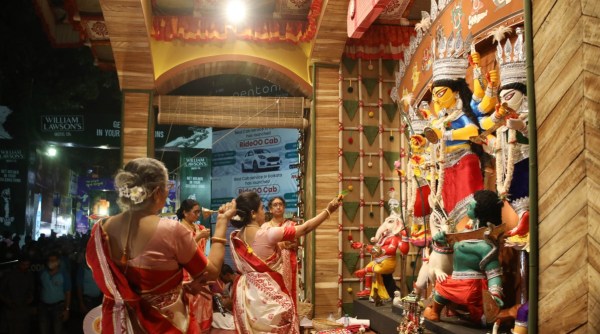Context
-
Recently, Durga Puja gets UNESCO Intangible Cultural Heritage tag on the Representative List of the Intangible Cultural Heritage of Humanity.
-
The 2021 Representative List of the Intangible Cultural Heritage of Humanity also has entries including Arabic calligraphy, Uzbekistan’s Bakhshi art, Congolese rumba, falconry, Inuit drum dancing of Denmark, and the traditional Italian knowledge and practice of truffle hunting and extraction.
About Durga Puja
- Although celebrated across the country — notably in Tripura, Bihar, Jharkhand, Odisha, Assam, Maharashtra, Delhi, and Uttar Pradesh — and in neighbouring Bangladesh, the heart of the 10-day annual Sharodotsav festival is in Kolkata, where more than 3,000 community Durga Pujas are held, apart from a large number of pujas in Bengali households.
- Kumartuli is the 3000-year-old clay-modelers hub in Kolkata that models Durga idols and even exports them to other parts of the world. Idol-makers in Kumartuli with the new UNESCO tag hoped for a revamp in infrastructure, working conditions, civic amenities.
- The inscription of Durga Puja of Kolkata in the UNESCO Representative List acknowledges the festival’s contribution in sustaining and safeguarding of a multitude of traditional arts and crafts, well-being and economic empowerment of communities, and energising creativity.
- Earlier this year, the British Council in India had mapped the creative economy of Durga Puja to over ₹32,000 crore for the year 2019 and added that the festival contributes 2.58% of West Bengal’s GDP.
What is Cultural Intangible Heritage ?
- According to UNESCO, “cultural heritage does not end at monuments and collections of objects”, but “also includes traditions or living expressions inherited from our ancestors and passed on to our descendants, such as oral traditions, performing arts, social practices, rituals, festive events, knowledge and practices concerning nature and the universe or the knowledge and skills to produce traditional crafts”.

Credit: Express Photo: Partha Paul, File - Intangible cultural heritage, according to UNESCO, is “traditional, contemporary and living at the same time”, “inclusive”, “representative”, and “community-based”.
- It is “an important factor in maintaining cultural diversity in the face of growing globalisation” — and “an understanding of the intangible cultural heritage of different communities helps with intercultural dialogue, and encourages mutual respect for other ways of life”.
How an Intangible cultural heritage is included in UNESCO’s list
- The state parties are required to submit nomination dossiers on the relevant element for evaluation and examination of the UNESCO Committee.
- The nomination dossiers are prepared by the Sangeet Natak Akademi under the Ministry of Culture after making necessary interaction with experts, stakeholders.
- The Ministry of Culture then designs schemes towards preservation and promotion of intangible cultural heritage in the country.
- Various autonomous bodies like Sahitya Akademi, Sangeet Natak Akademi, Indira Gandhi National Centre for Arts, zonal Cultural Centres, National School of Drama, Anthropological Survey of India function in various spheres.
- The Ministry of Culture has implemented several schemes for providing financial assistance to artists and institutions for the promotion and preservation of the cultural heritages.
- UNESCO recommends countries develop inventories and work with groups to ensure their continued existence.
- It also provides for finds collected voluntarily by member nations and disbursed to support the maintenance of the recognised element
Intangible Cultural Heritage tags
- With the inclusion of Durga Puja, the number of elements in the list of Intangible Cultural Heritage from India has increased to 14.
- The Representative List of the Intangible Cultural Heritage of Humanity currently has 492 elements.
- China has the highest number of elements followed by France and Japan.
Representative List of the Intangible Cultural Heritage of Humanity from India
| S.No. |
ICH Element |
Year of Inscription |
|
|
Tradition of Vedic chanting | 2008 |
|
|
Ramlila, the traditional performance of the Ramayana | 2008 |
|
|
Kutiyattam, Sanskrit theatre | 2008 |
|
|
Ramman, religious festival and ritual theatre of the Garhwal Himalayas, India | 2009 |
|
|
Mudiyettu, ritual theatre and dance drama of Kerala | 2010 |
|
|
Kalbelia folk songs and dances of Rajasthan | 2010 |
|
|
Chhau dance | 2010 |
|
|
Buddhist chanting of Ladakh: recitation of sacred Buddhist texts in the trans-Himalayan Ladakh region, Jammu and Kashmir, India | 2012 |
|
|
Sankirtana, ritual singing, drumming and dancing of Manipur | 2013 |
|
|
Traditional brass and copper craft of utensil making among the Thatheras of Jandiala Guru, Punjab, India | 2014 |
|
|
Yoga | 2016 |
|
|
Nawrouz, Novruz, Nowrouz, Nowrouz, Nawrouz, Nauryz, Nooruz, Nowruz, Navruz, Nevruz, Nowruz, Navruz | 2016 |
|
|
Kumbh Mela | 2017 |
| 14. | Durga Puja (Kolkata) | 2021 |
Visit Abhiyan PEDIA (One of the Most Followed / Recommended) for UPSC Revisions: Click Here
IAS Abhiyan is now on Telegram: Click on the Below link to Join our Channels to stay Updated
IAS Abhiyan Official: Click Here to Join
For UPSC Mains Value Edition (Facts, Quotes, Best Practices, Case Studies): Click Here to Join
